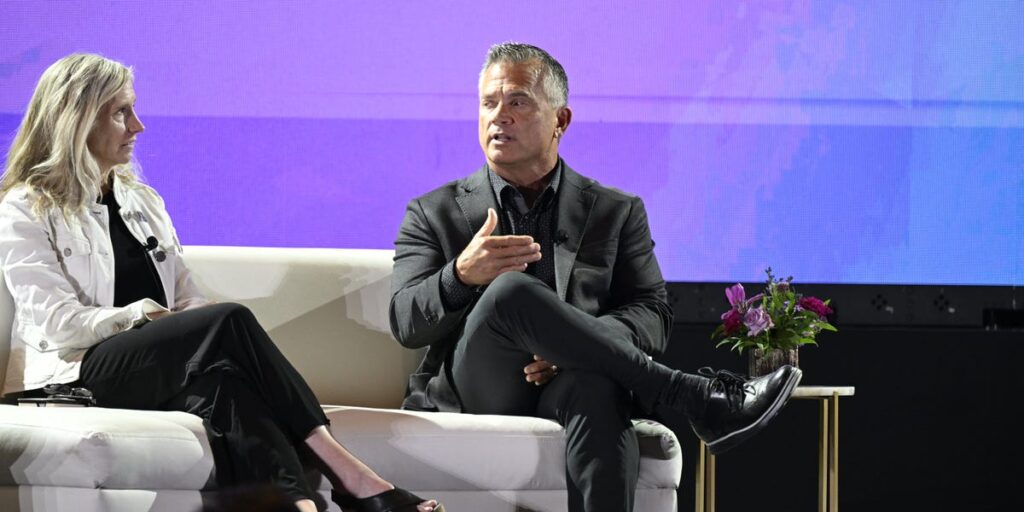For all the attention AI gets, some entertainment industry veterans think it’s still under-discussed — and underestimated.
“We’re in the first inning of generative AI. It’s going to explode — absolutely explode — and people do not see it coming,” said Bill Abbott, the CEO of Great American Media, which showcases family-friendly and faith-based movies.
But how are media companies already using AI? Business Insider recently heard from 11 media and entertainment leaders about how they’ve already implemented AI — and the breakthroughs they think it could deliver soon.
Execs from companies like A+E Global Media and YouTube shared how AI can bring better recommendations and search features while transforming how content is delivered globally.
1. Recommendations that really know you
Audiences are drowning in an ocean of content, and many companies are betting AI-enabled recommendations can serve as a life raft.
There are dozens of streaming services, nearly 2,000 always-on channels on free ad-supported streaming TV (FAST), and an endless firehose of user-generated content on YouTube and TikTok.
In this cutthroat battle for attention, content providers are using AI to make smarter suggestions about what to watch based on a viewer’s interests, watch history, or even the time of day.
“We’ve really gone from the era of peak TV to the era of personalized TV,” said Adam Lewinson, free streamer Tubi’s content chief. Lewinson said the popular free streamer’s tailored recommendations have helped lure younger viewers from social media, video games, and texting.
A Tubi spokesperson said the streamer has used machine learning to personalize home screens for the last eight years, and the recommendations have improved and become more sophisticated over time.
The anime-focused streamer Crunchyroll is also curating personalized recommendations with AI, said Brian McGarvey, its global distribution head.
Several streaming execs said they see this as a weapon in an existential battle against TikTok and YouTube.
“If the FAST universe doesn’t move in that direction, my perception is that it will fail,” said Erick Opeka, the strategy chief at free streamer Cineverse.
2. Search is getting smarter
Algorithms aren’t the only way to find what to watch next.
Platforms like Netflix are using AI-powered search to improve content discovery. Viewers can search by genre, theme, and vibe — or by using natural language, like “scary, but not too scary” or “I need something to cheer me up.”
“You can search across all kinds of parameters, in ways you could not search before,” said Tony Huidor, Cineverse’s chief product officer. The company just released an AI-powered search engine called CineSearch, which other streamers can license. It also includes a chatbot.
Streamers’ search engines have often relied historically on simple metadata, like the title or actors.
Scott Alexander of digital video software firm Bitcentral said that before AI search, a query that didn’t include terms from the title or description would likely fail. AI search features can help change that by mimicking how a person would help someone choose a movie.
3. A/B testing to infinity
AI also allows video platforms and content creators to do more testing on the creative front.
Streamers have tested multiple thumbnails for years, but now they can use AI-powered A/B tests to supercharge their efforts.
This could better connect audiences with content while saving time, said Abhishek Neralla, a content exec at A+E Global Media. A+E hasn’t yet used AI for these A/B tests but is exploring doing so.
Bitcentral’s Alexander said that with AI, media companies can leave less to chance by creating a few hundred or even 1,000 different versions of an ad with small variations that advertisers can test to see which gets the most engagement.
AI could also help with the creative process itself.
Paul Snow, YouTube TV’s head of sports and studio partnerships, said tools like Google’s Gemini can also help make brainstorming new videos easier. He said these AI tools can “reduce the amount of time” creators need to spend deciding what topic to tackle next.
4. Going global, instantly
AI promises to give media companies and creators the opportunity to help their videos travel around the world.
YouTubers can now instantly add AI-enabled subtitles or dubbing in different languages, said Fede Goldenberg, YouTube’s head of TV and film partnerships.
Creators who only speak English can put their videos in Spanish, Japanese, Hindi, or other languages, which presents an opportunity to reach legions of new fans.
The inverse is also true, as global creators can more easily connect with English speakers. That could make the US market even more competitive.
“We’re now able to dub and subtitle all of our content,” said Eric Orrantia, the sales exec at Korean streaming service ODK Media. Orrantia said this helped ODK grow its viewership from around 5.5 million people in Asia to roughly 60 million engaged viewers globally.
5. How far will AI special effects go?
While AI has tantalizing potential, it’s a double-edged sword for creators since AI-generated content could also distract viewers from movies and TV shows made by humans.
AI video tools like OpenAI’s Sora and Google’s Veo 3 have pushed the limits of what is possible in video generation. However, the days of creating studio-caliber footage at the push of a button have not yet arrived, said Joshua Reader, the CEO of creator crowdfunding platform CreatorCut. He added that some creators are still wary of AI-created video.
That said, AI has already entered Hollywood’s post-production process. Studios are using AI tools like Runway, and AI was used in post-production of some of this year’s Oscar nominees.
Netflix co-CEO Ted Sarandos said earlier this year that he felt AI could be used to improve films in new ways instead of just cutting costs.
“Traditionally, only big-budget projects would have access to things like advanced visual effects, such as de-aging,” Sarandos said. “So, today, you can use these AI-powered tools to enable smaller budget projects to have access to big VFX on screen.”
Read the full article here


